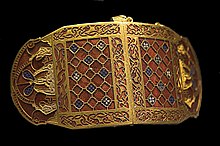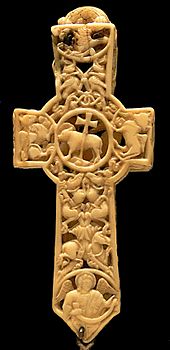

Anglo-Saxon art covers art produced within the Anglo-Saxon period of English history, beginning with the Migration period style that the Anglo-Saxons brought with them from the continent in the 5th century, and ending in 1066 with the Norman Conquest of England, whose sophisticated art was influential in much of northern Europe. The two periods of outstanding achievement were the 7th and 8th centuries, with the metalwork and jewellery from Sutton Hoo and a series of magnificent illuminated manuscripts, and the final period after about 950, when there was a revival of English culture after the end of the Viking invasions. By the time of the Conquest the move to the Romanesque style is nearly complete. The important artistic centres, in so far as these can be established, were concentrated in the extremities of England, in Northumbria, especially in the early period, and Wessex and Kent near the south coast.
Anglo-Saxon art survives mostly in illuminated manuscripts, Anglo-Saxon architecture, a number of very fine ivory carvings, and some works in metal and other materials. Opus Anglicanum ("English work") was already recognised as the finest embroidery in Europe, although only a few pieces from the Anglo-Saxon period remain – the Bayeux Tapestry is a rather different sort of embroidery, on a far larger scale. As in most of Europe at the time, metalwork was the most highly regarded form of art by the Anglo-Saxons, but hardly any survives – there was enormous plundering of Anglo-Saxon churches, monasteries and the possessions of the dispossessed nobility by the new Norman rulers in their first decades, as well as the Norsemen before them, and the English Reformation after them, and most survivals were once on the continent.[1] Anglo-Saxon taste favoured brightness and colour, and an effort of the imagination is often needed to see the excavated and worn remains that survive as they once were.[2]
Perhaps the best known piece of Anglo-Saxon art is the Bayeux Tapestry which was commissioned by a Norman patron from English artists working in the traditional Anglo-Saxon style. Anglo-Saxon artists also worked in fresco, stone, ivory and whalebone (notably the Franks Casket), metalwork (for example the Fuller brooch), glass and enamel, many examples of which have been recovered through archaeological excavation and some of which have simply been preserved over the centuries, especially in churches on the Continent, as the Vikings, Normans and Reformation iconoclasm between them left virtually nothing in England except for books and archaeological finds.